Story stones are probably one of the most well-known resources for encouraging children to become independent story-tellers. They feel so natural and part of humanity’s storytelling past. But what do you do with them when you’ve got them?
Here’s the quick answer. How do you use story stones? Some of the most effective ways of using story stones are:
- Pick them out of a story bag randomly
- Use blackboard paint stones for independent mark-making
- Have four baskets of stones – character, setting, problem, resolution
- Use abstract stones
- Use coloured stones
- Use character stones in small world
- Use character stones linked to a story
- Use assorted stones in free play
- Balance the stones on something
- Pick one stone per child
- Create a mark-making story
I have been using story stones in many ways for the last ten years. Here is my full illustrated guide on how to get the best out of them, how to use them, how to make them and some great do’s and donts.
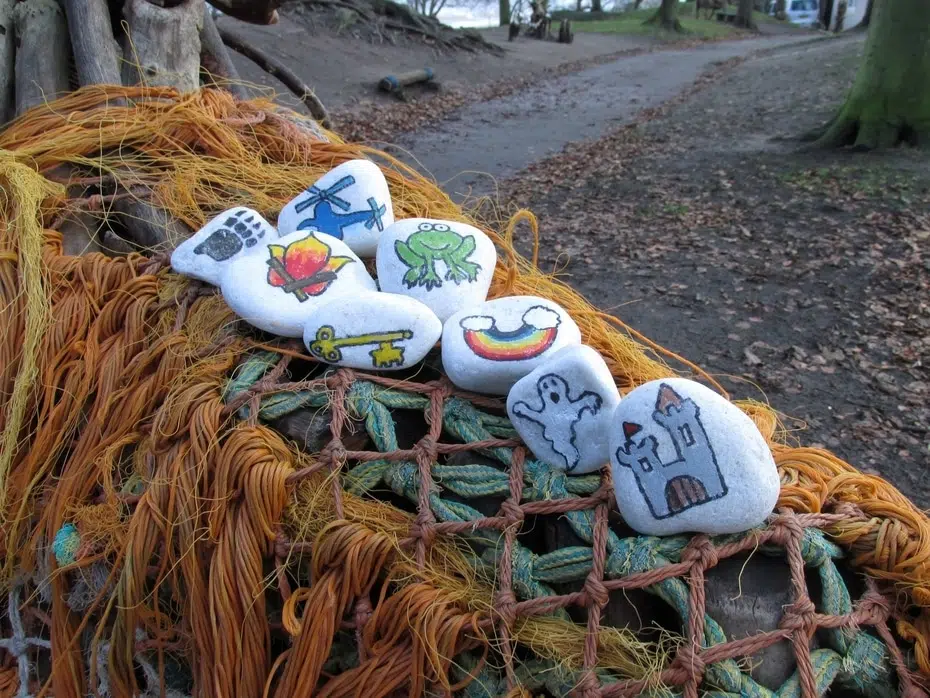
How To Use Them
1. Use A Story Bag
This is probably the simplest way of getting the children started using story stones.
It is also possibly my most well-used, particularly when using the stones in an adult-led context.
The idea is simply to have a selection of story stones, and put them in a bag. Then you get a child to take one stone out and you start a story. Then the next child takes a stone out and you continue it.
The adult can help as much as is necessary. You may need to tell pretty much the whole story to start with. You hope, however, that when they get into it that the children will become better at making up the story or at least parts of a story themselves.
A quick heads-up about how to make basic story stones before we go much further. The stones I use the most are the ones in the picture at the top of this article.
They are white stones with different pictures painted on. I like the white of the stones, because it really helps to bring out the colour of the images. I used a sharpie pen for the outline and acrylic paint for the colour. There are four types of stones – characters, settings, problems, resolutions.
As a simple outline you want a good mix of the following:
- Characters – you want some good and bad characters. Examples of goodies are things like a cat, a rabbit, a princess, a frog, a parrot, a little girl. For bad characters think of things like a wizard, a witch, a dragon, and lots of other things like that.
- Setting – Think magical fantasy settings. Good examples would be things like a spooky cave, a castle, a dark wood, the sea, and many other settings like this
- Problem – These are basically bad things that can happen in the story. Think of things such as a poisoned apple, a fire, a huge wave, a sea serpent, a letter, a storm. Also a baddie can be a problem. Creating things like zombies, ghosts, wolves and crocodiles really help make some imaginative problems.
- Resolution – These are things that will sort out the problem. It is often quite random, and often with children random stories are the way to go. Example resolutions are things such as a rainbow, a unicorn, a magic key, a wand, or a letter. A little bit of magic often helps things along.
In the story bag method I usually go with a random story. They just pick out a mixture of the four types of stone, and you go with that. Random, unwinding stories that have multiple settings, cliff-hangers and story twists.
However, if you want to get a bit more structure into your story then use the next method…
2. Use Four Baskets Of Stones
This is the next step from the method of creating random stories.
This starts off the kind of structure that children are going to be using in creating stories later on in their education.
The idea is to choose four baskets, or it could be four bags. If you can label them in some kind of way then that is definitely a good thing as well.
The baskets or bags are going to labelled with the four types of stone – ‘character’, ‘setting’, ‘problem’, and ‘resolution’.
Then you quite simply split up the stones into these four separate units.
There are several ways you can use this structure. The most obvious and best place to start is in an adult-led context. Get a child to take a stone out of the first basket. If it is, for example, a rabbit, then start the story something like ‘Once upon a time there was a little rabbit…’
Then move on to the next basket – ‘setting’. For example, ‘One day he crept into a dark, spooky cave.’
Then go on to the next, e.g. ‘In the cave was an evil witch. She put a spell on him and turned him into a frog.’
From the last basket – ‘Suddenly the frog found a magic key. It opened the witch’s treasure chest of potions. The frog drank a potion and turned into a unicorn. He speared the witch with his horn, and was free.’
Again the adult just needs to get involved as required. Ask questions and give them time to think. Stories are sometimes hard to come up with straight away.
The next step is each child takes a stone from each basket in turn, so they each have four. Then they try to generate their own story.
3. Use Blackboard Paint Stones
This is much more child led, and the children become more responsible for their learning.
Simply paint some stones using blackboard paint. It doesn’t necessarily need to be black – just any colour. The main thing is that the children are then able to draw on them using chalks.
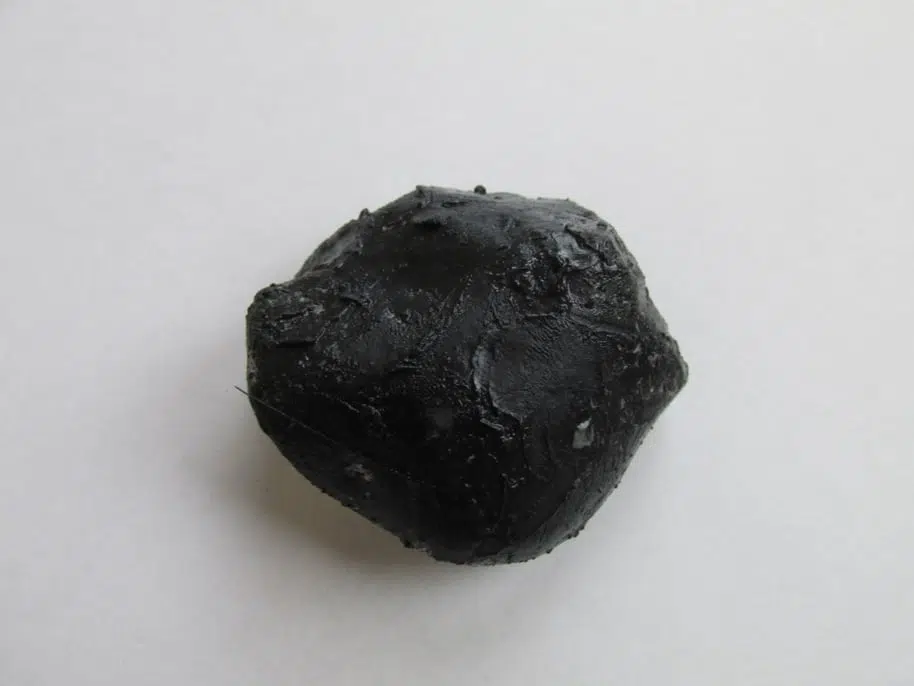
This is a good thing to try when the children have been given an exposure to how to use the stones.
They can draw their own characters, settings, and everything else on the stones. Some picture prompts often work well, as some children need support to come up with their own ideas.
It is no problem at all if their pictures don’t look like much. The main thing is how they use the stones and the talk and imagination that is generated.
These stones are great for placing in small world provocations or areas. Just a few stones can spark child-led mark-making in unusual areas. Ownership is one of the key motivators for young children in learning (check out the main other motivators in this article I wrote).
4. Use Abstract Stones
These are very much a next step, and I tend not to do these with very young children between the ages of 2 to 4. After this though, these stones can work brilliantly.
The idea is rather than clear images on the stones, you draw abstract lines. Good examples would be a zigzag line, a springy line, a line that looks like a wave, dots, and circles.
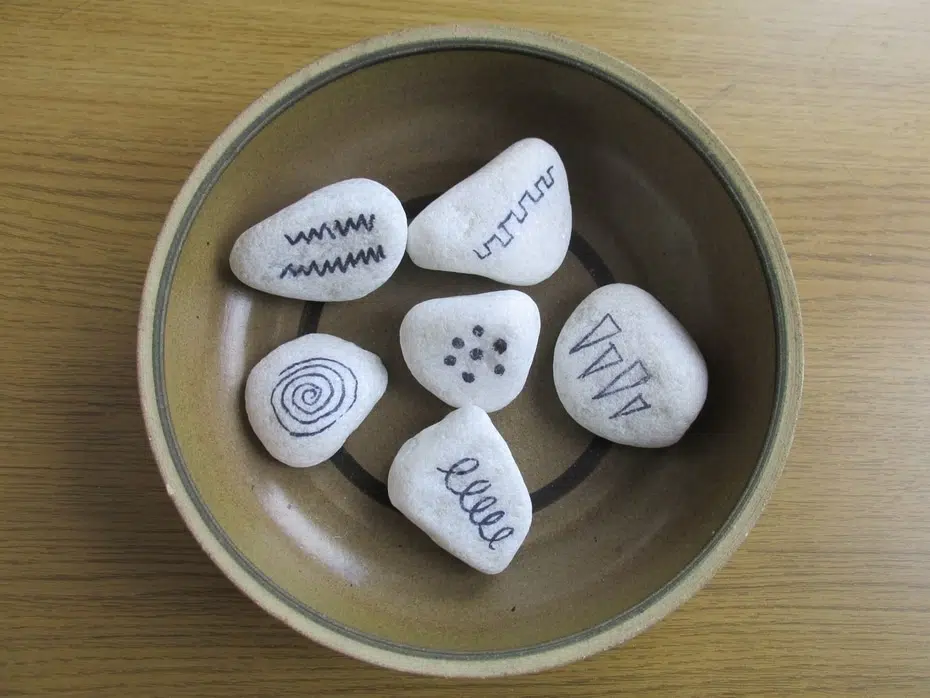
The idea is that the child that picks up a stone decides what that line represents. For example, the zigzag line could be a mountain range, or shark’s teeth, or a saw, or whatever they can think of.
You can use a whole set of abstract stones to make up a story. This is the harder version of using them. You pick a stone one at a time, and just come up with things that the lines may represent.
This requires extra imagination, and the children filling in the gaps mentally.
The easier way of using them, is to mix them in with the normal story stones. Then you will have abstract stones crop up in the story, and you can fill in the blanks then. Some of the abstract images are really open-ended and have lots of possibilities. The stone with dots on can be many different things – such as hailstones, rain, meteors, peas, beans, pebbles, stars, a beach. The list is nearly endless.
These stones are also fantastic for simple mark-making stories. If children are at the point when they can attempt writing patterns, then these stones are fantastic. Use big wallpaper on the floor, or big chalks. Pick an abstract stone, make up what it is, and all try to draw the writing pattern on the big paper.
This type of story-based mark-making is brilliant for more reluctant writers in particular.
5. Use Coloured Stones
This idea is also fairly abstract, and so it is open-ended which is wonderful for children to take control of their own learning.
You quite simply get a selection of stones and then paint them in different colours. This may seem slightly time-consuming, yet as with all of these story stones ideas, when you have made these stones, you have them for life.
The idea of having different colours of stones is that they can then represent different things.
For example, a pink stone could be a little pig. A red stone could be a fire engine, or an apple, or whatever you want really.
These stones are great for small world provocations. I used some recently for the Three Little Pigs – three pink stones (for the pigs), a brown stone (for the wolf), and a few other random stones for use as props in the story.
That is reasonably adult-led in its idea, but it gets the children started in the process. Often open-ended learning can come following the original understanding of how a resource can be used.
More skilful children could easily use just an array of differently coloured stones and come up with their own ideas as to what they represent.
They are good for transitional art also, and for use outside.
6. Use Character Stones From A Story
Stones can also be transformed into specific characters.
This is brilliant if your children are interested in a specific book, or if you teach around story based themes. Why not bring the story to life with painted stone characters from the book?
Here are my Hairy Maclary stones:
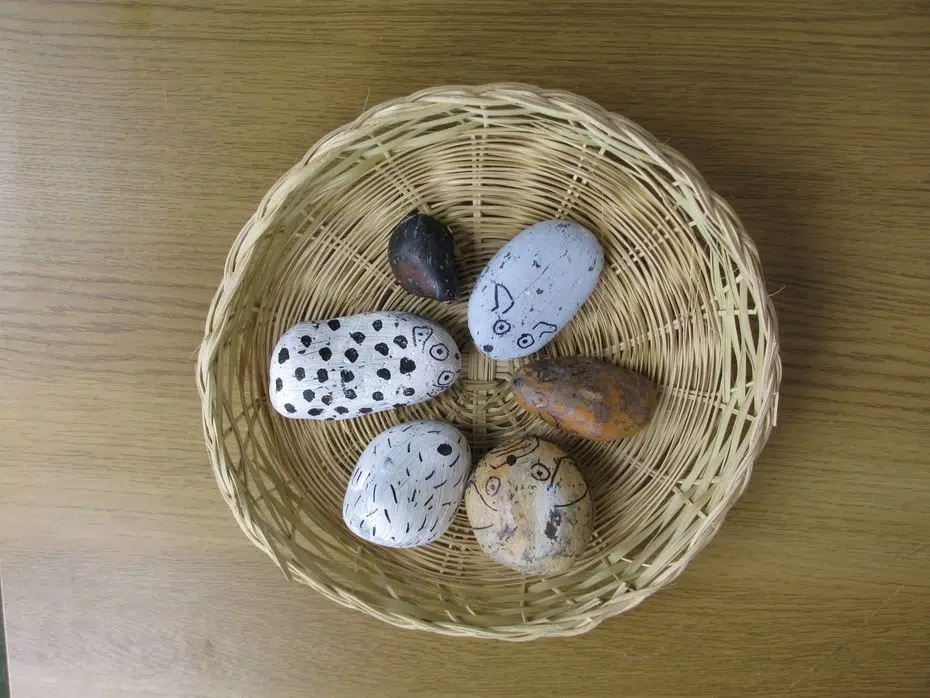
The children have always loved these. They represent the many different dogs in the stories. The paint is coming off them a bit now because they are so well-used, but this only really adds to their character.
They are fantastic in child-led play and small-world investigation. Because there are so many Hairy Maclary stories as well, these stones are a great investment of time. The link brilliantly to about twenty different books.
I look the link of these stones to mathematical learning. They are great for weighing, as they all weigh different amounts.
They are also all different sizes so you can talk about the different lengths and widths.
I enjoy using them to count with. You read a Hairy Maclary story and act it out using the stones. It is great to count at different points, and check how many dogs there are. Several of the stories use the structure of there being one more or one less dog on each page, great for early calculating.
Sometimes just one stone is all you need. A Gruffalo stone, for example, is a great addition to any small world provocation.
Most characters can be simply created using a stone. It does not need to be a masterpiece! Just paint the stone a suitable colour, and then add a couple of lines with a sharpie pen to represent whatever it is supposed to be.
7. Character Stones In Small World Play
You could also just have some more open-ended character stones added to a learning area. For example, a ghost, a pirate, or a dragon could take on a role from a story, or just be a generic ghost, pirate or dragon.
Character stones are fantastic outside.
There is something magical about just find a painted stone in an outdoor fairy garden, or in a digging plot.
There is the element of surprise, and the sparking of talk and enquiry. Such surprises also generate that feeling of awe in the surroundings that many children don’t always get enough of.
Children love to talk to characters. They tell them what they’re doing, ask questions, and sometimes even boss them around.
All this is great for them structuring their thoughts, and thinking about their lives and the world around them.
8. Assorted Natural Stones
You can of course paint stones, and jazz them up in lots of different ways. However, even simpler than this is if you can get your hands on some multi-coloured and differently sized stones.
These do take a bit of getting used to for the children. They do not often link them to story-telling by chance.
However, if you show them the kinds of things they can do with them, or even better get involved in their play and link them in, then simple multi-coloured stones can become anything in your story.
A white and green one can be a lagoon, or the rolling sea. A black and yellow stone some kind of tiger or leopard. They don’t even have to look like what you are saying they are.
This is simple, primal story-telling that I would like to believe our ancestors engaged in.
Using simple objects as props to let the story flow.
9. Balance The Stones On Something
Balance the stones on something
This is a kind of DIY play hack that I have tried, and that children seem to really respond to.
You basically get some kind of object that the children can balance the stones on. It then becomes a kind of storytelling mountain. You put a stone on, tell a bit of the story, and then put on the next stone.
In the past I have used a kind of old candle holder that I found in a charity shop. Here is a picture of it here:
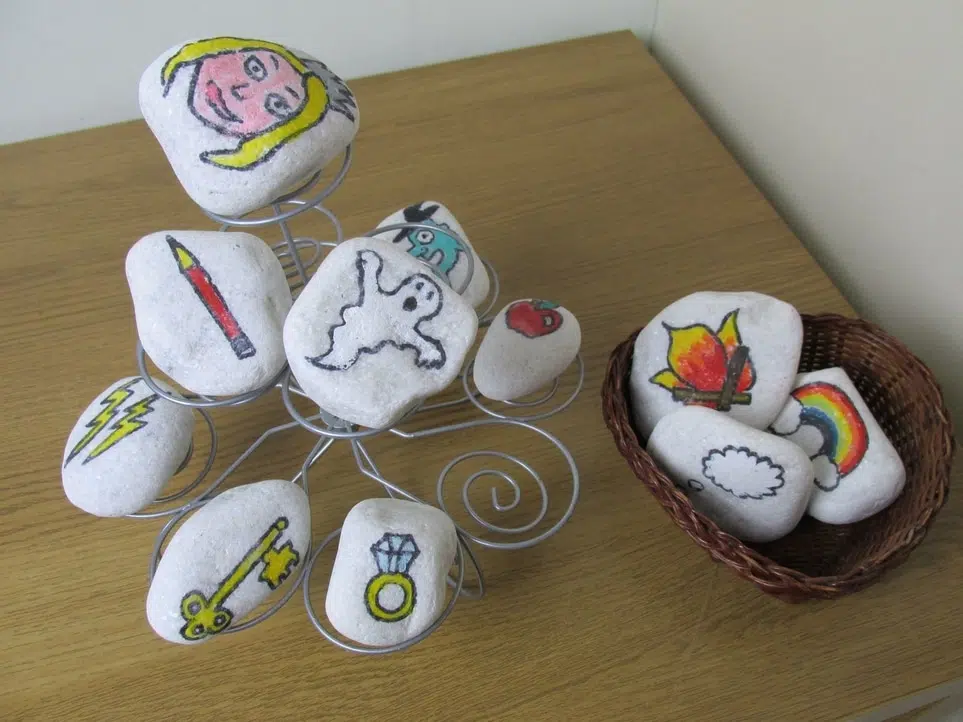
There are other things you could use. Just an old interesting bowl will work well. Or one of those dishes with different sections.
There is just an element of curiosity when you build a story in this way. It becomes a tactile balancing experience, as well as getting the children thinking and talking about story elements.
10. One Stone Per Child
This is a simple pass-the-bag style game. It is like a circle game, and good for including everyone.
You simply have a bag of story stones (if you don’t want them to look inside). If you don’t want them to look at the stones first, then use a box without a lid.
The advantage of letting them look at the stones first is that some children like to choose what happens next. If there has just been a fire in the story, they want there to be a storm to put the fire out.
This is great. They are thinking about next steps, and joining story elements together. In this way, you may well get a story that seems more coherent and less random.
With either the bag or box, you simply pass the stones round and they all take one. There are several games you can do:
- Musical stones – stand up and play some music. The children walk round in the group, and when the music stops they pair up with someone. They try to make up a story with their two stones. Repeat by walking round again, and then once again stopping the music.
- Another fun game is an ‘And Then’ story. Each child sitting in the circle with their stone will get a go. The first person will say, ‘One day there was a ghost’. The next person will always say ‘And then’ to begin the next sentence. For example, if they were holding the sea stone, they would say something like ‘And then ghost went on a boat on the sea.’ Continue round the circle. It will be random, but children enjoy this and often find it funny. The structure helps the less confident to be included.
- Team up in numbers of approximately four or five. Work together to come up with a story.
11. Create A Mark-Making Story
Stones can link brilliantly to mark-making.
This is the first step in creating story maps and story boards later on.
Use a big wallpaper on the floor, or chalks on the ground, or whatever other exciting ways of mark-making you have available.
Having a few simple writing utensils available wherever you have the story stones in your setting is a great idea. Then children can choose to mark-make themselves.
Of course, in the real world many children do not choose to mark-make and will need a bit of adult encouragement.
Abstract stones are excellent for mark-making. Their simple patterns such as zigzags and dots are super for younger children, and those at that level of development. Positive fine motor activities such as this have a range of benefits for young children.
The stones with pictures on can also be simplified to this level. A cave could be a circle, the sea a wiggly line.
Children like to add marks to these stories that really represent action or conflict. For example, if you have drawn a witch going to a spooky wood, children may draw something like fire exploding out of her wand. Just a few ferocious lines make this enjoyable and relevant.
For more experienced children, drawing simple story maps may be possible.
For younger children, just simply creating a few marks that represent character, location or problem is fantastic.
How To Make Them
There are many different ways to create story stones. It may depend on how artistic you feel before starting.
I think the most important thing to remember is they don’t have to look like masterpieces. People often see incredible creations on pinterest and other social media, and get scared to try things themselves, in case they don’t look as good.
It really is not a problem.
Just go for it!
Basic Materials
Stones
Pick some good quality stones. You can get stones very cheaply from builder’s yards and DIY stores. In the past I have used different coloured stones, but my favourite ones are definitely the white stones. They are magical and sparkly, and look like they have come from another world.
If in doubt I would go for slightly smaller stones, rather than larger ones. They are a bit smaller and more other-worldly, as well as being safer.
The stones I bought cost about $10 for about 150 of them. All I needed to do was give them a quick wash when I bought them and they were ready to go.
I used these same stones for quite a few different projects. They were good for number stones, for stories linked to counting.
Pens
You also need something to draw the images with.
I normally use permanent marker pen for the outlines. You can also colour in the stones with permanent marker colours as well.
Colour is not always required. For example, for the abstract stones, all you need is pen for the lines.
The images as well do not necessarily need to be coloured in. They can work fine as just pictures on a stone.
Paint
I always paint them with acrylic paint. This will not come off even in the rain. To make them even more rain-proof, add a varnish of PVA glue.
I have worked with a nursery that has had acrylic painted stones with PVA varnish on outside for at least four years, and they basically still look the same now as they did when they made them.
Where Do You Find The Picures?
I just google things like story pictures, clip art goodies, clip art bad characters, and lots of other things like that. Just simply try to copy them.
If you do not like art, then you can always print pictures out from the internet and glue them with PVA onto the stones. This is a very quick process, and will also save you time. Perfect if you don’t think your art skills are up to the job.
If given the choice I would always make my own, as this makes them seem magical and natural. However, it really is not essential.
Some Things To Watch Out For
Story stones are usually a beautiful, safe resource to use fo the vast majority of children. However, there are some children that will have to be supervised when using them.
The main thing to watch out for is if you have a ‘thrower’.
These are the children that impulsively throw objects around in the setting. It can be a behavioural symptoms of a condition – for example many children with ADHD will often throw items regularly.
A thrown story-stone can do huge amounts of damage to others, so a thrower would either have to be supervised very closely, or else an alternative resource used instead.
I have found there are an increasing number of children that throw things in modern education, and so this is a key thing to look out for.
Variations On Story Stones
If you have throwers, then there are alternatives to story stones that are safer and lighter.
I found these magical glittery eggs in a charity shop. They are super light, but great for putting pictures on and using like story stones.
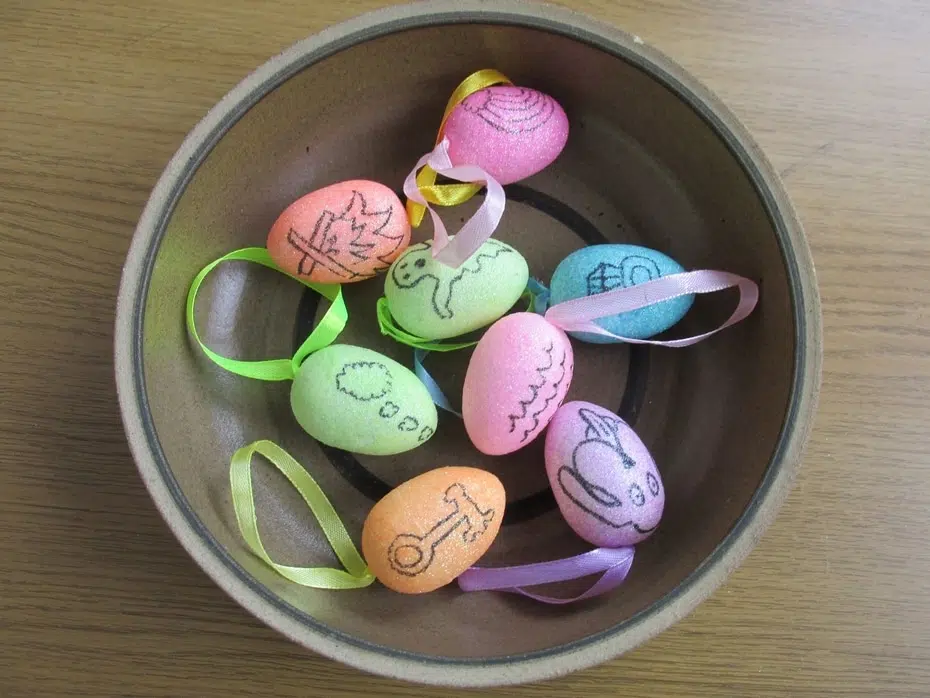
You can also get polystyrene balls. Even small pieces of wood or chopped up branches would work well, with small images drawn on. These are better if you have a setting that utilises lots of natural objects.
Story spoons are also a very popular thing at the moment. These work in a similar way to story stones, but can be safer for young children in child-initiated contexts.
Story spoons can also be used as a kind of puppet, and used as a vehicle to use different voices and get into character.
There are probably lots of random objects around your setting that you can add a few pictures to, and create a fabulous storytelling resource. Even something as simple as duplo can be turned into a story tower with a few pictures drawn onto it.
Related Questions
How do you use story dice? Get children to roll the story dice. Put the dice in a line and try to tell the story. Otherwise, roll one dice at a time, describe what you see, and then roll the next dice. This game is good for playing in a small group.
How do you use story spoons? Use story stones a bit like puppets. You can place them in front of your face, and act out using the voice of that character. They are great for repeated refrains in stories like the Three Little Pigs. Story spoons can be a part of provocations, and small world play with other resources and equipment. For a full guide on using story spoons, check this article out.
How do you get children to retell stories? Allow children to listen to stories at every available opportunity. Repeat stories they like and encourage them to join in with actions, chants and character voices. Retell well known stories verbally using props, toys or pictures, getting the children to try to join in.
Anywhere else I can read about story stones? One of my very favourite education blogs has a fantastic article about story stones. Read Juliet Robertson’s ideas about story stones here – https://creativestarlearning.co.uk/early-years-outdoors/10-ideas-for-using-story-stones/This post provided fantastic inspiration for me when I was first starting out with story stones.
READ MORE

Martin Williams
Friday 2nd of August 2019
Thanks, Wendy! That's great news
Wendy
Sunday 28th of July 2019
You've inspired me! Thank you